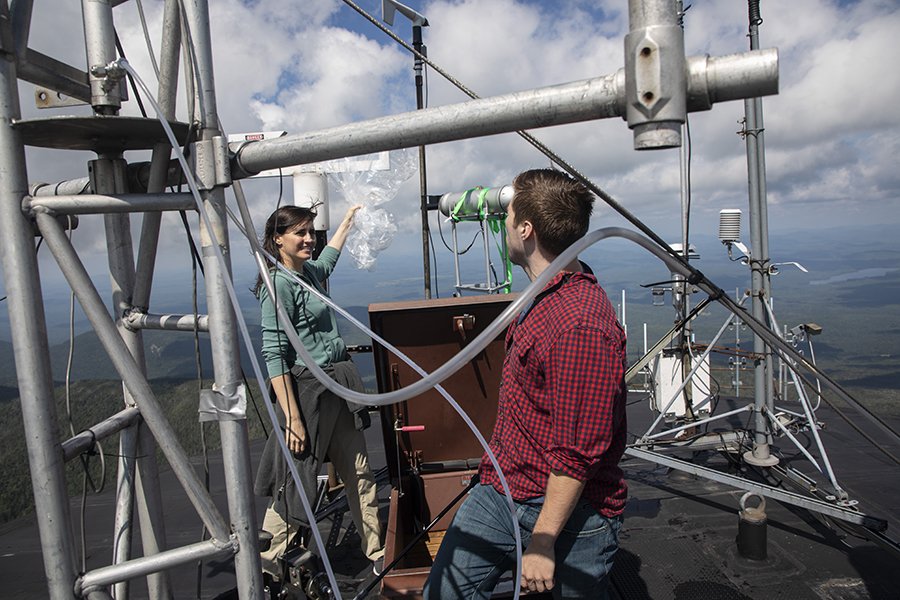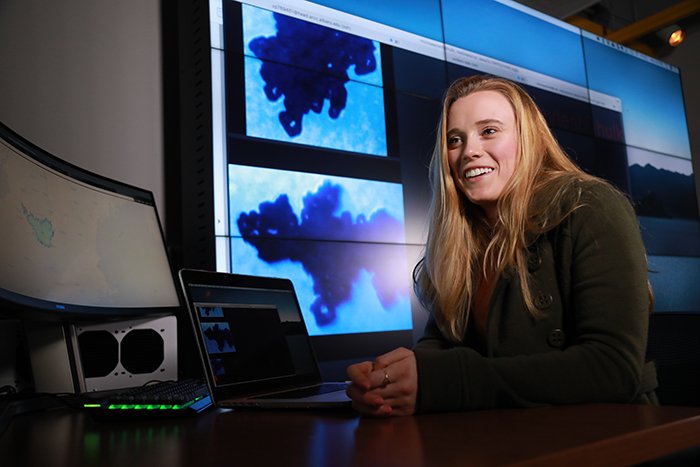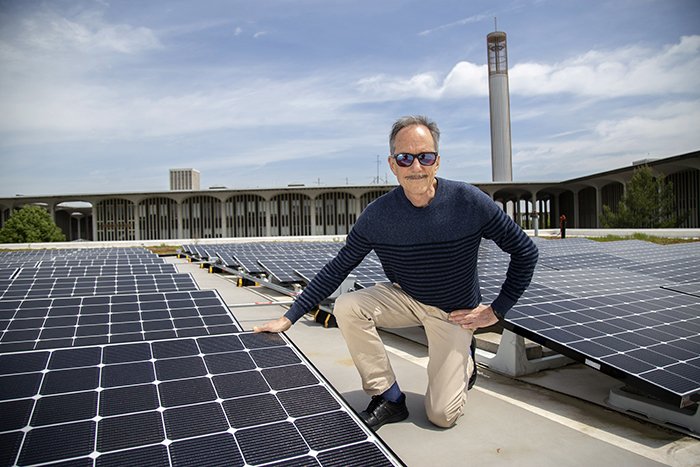Atmospheric Sciences Research
The Atmospheric Sciences Research Center maintains unparalleled research expertise in a wide range of atmospheric science disciplines across multiple facilities. ASRC is the resource for basic, applied and experimental research in atmospheric sciences.
ASRC Research Areas
Researching concentrations of aerosols (and precursor gases) in the atmosphere and how they influence weather and climate, air quality and human health.
Researchers: Sara Lance, Cheng-Hsuan Lu, Kara Sulia, Wei-Chyung Wang, Fangqun Yu
ASRC faculty and their groups are working on various aspects of aerosol-cloud-precipitation interactions, through in-situ measurements, remote sensing, theoretical investigation, numerical modeling and machine learning, with funding support from NSF, NOAA, NASA, NYSERDA and DOE.
Aerosols may directly interact with radiation through absorption and scattering (aerosol-radiation interaction), or indirectly through aerosol-cloud interactions by acting as cloud condensation nuclei or ice nuclei. The indirect interaction is the more uncertain of the global climate models associated with aerosols.
The Twomey Effect or the First Indirect Effect is the increase in number and reduction in size of cloud droplets due to increased aerosol concentrations that ultimately increases (typically) the cloud albedo for a cloud of constant liquid water content and vertical extent. A consequence of smaller cloud droplet sizes is the modification of the coalescence of droplets and even the mechanisms for freezing in mixed-phase clouds, which hinders precipitation – the Albrecht Effect or Second Indirect Effect also known as Cloud Lifetime Effect due to the importance of precipitation in cloud lifetime. Hindered precipitation may allow for farther transport of clouds, thereby affecting the spatial distribution of latent heat release as well as ultimately water that can precipitate elsewhere, which affects the atmospheric energy balance.
Aerosols can also affect cloud formation dynamics; for instance, black carbon can efficiently absorb radiation, warm the atmosphere, and cause cloud droplets to evaporate. On the other hand, cloud processing and precipitation affect the concentrations of aerosols (and precursor gases) in the atmosphere, which, in addition to their influences on weather and climate, can also impact air quality and human health.
Weather data is big data, and to harness the scientific possibilities requires the development and training of innovative analytical techniques, such as Machine Learning.
Weather data is big data, and to harness the scientific possibilities from these data require the identification of, training for, and utilization of innovative analytical techniques. The Atmospheric Sciences Research Center recognizes the need to add techniques in Artificial Intelligence (AI), such as Machine Learning (ML), to its already robust modeling toolbox.
ASRC is on the vanguard of developing weather and climate-centric capabilities. This includes the establishment of the ASRC ExTreme Collaboration, Innovation, and Technology (xCITE) Lab. With growing expertise in data analytics, software development, and importantly AI/ML, the xCITE lab serves as a virtual and physical infrastructure for innovative computing at ASRC. Outfitted with state-of-the-art high-end scientific visualization and GPU/CPU high-performance computing, the laboratory serves as a multi-disciplinary collaboration space for research and development across University groups as well as with public and private partners.
ML is useful in situations in which manually producing rules for label distinction is laborious. In particular, feature selection and pattern recognition output from a machine is most useful when considering the abundance of correlations that can be glossed over by a human. ML algorithms provide the capability to quickly and efficiently operate on mass data and identify features otherwise unnoticed by even a trained-eye, and perhaps ignored given the abundance of data, which would nearly be impossible to personally analyze. To function appropriately, accurate uses of ML require large quantities of data of the same type. Weather in its ever-reliable persistence provides the atmospheric science community with an unprecedented data playground in measured and modeled forms.
Understanding our atmospheric environment, the health effects of polluted air, and the connection of chemistry and aerosols to the broader topic of climate change.
The atmospheric chemistry and aerosols group deals with the measurements and modeling of atmospheric trace gases and aerosols, air quality and aerosol modeling, cloud formation and chemistry, and chemical processes leading to formation and growth of new particles and cloud condensation nuclei. These activities help scientists understand our atmospheric environment, the health effects of polluted air, and the connection of chemistry and aerosols to the broader topic of climate change. Many of these activities focus on air pollution, air quality and particles within New York State. However, these issues are global in nature and ASRC researchers frequently collaborate with colleagues throughout the nation and the world.
Measurements of atmospheric chemistry and air quality are taken at a variety of fixed surface locations in New York State and from a mobile laboratory. The fixed sites allow for long term measurements to help track progress in air quality and changes in the emissions and concentrations of trace gases and aerosols. Generous support for these measurements have been supplied by the New York State Energy Research and Development Authority (NYSERDA). These measurements and the resulting data repository are a rich resource that is used by ASRC scientists, and by colleagues from many other organizations.
ASRC maintains year-round research at Whiteface Mountain Observatory in the Adirondacks, which has been active for over 50 years. We measure trace gases, aerosols, meteorology, and precipitation routinely at the summit observatory and the affiliated lodge site halfway up the mountain. Whiteface Mountain is often enveloped in clouds and is a prime location for cloud-related studies. Cloud water chemistry is measured during the summer months. Ongoing research seeks to track the changes in chemical composition of atmospheric gases, aerosols, clouds and precipitation; as well as the aerosol-cloud-climate interactions at this high-altitude location.
Air quality and aerosol modeling at ASRC seeks to integrate our understanding of atmospheric chemistry and meteorology to provide forecasts and research tools for scientists and the public. Air quality models are used to investigate how pollutant distributions are affected by local weather patterns, conduct retrospective analysis to interpret polluted events, characterize pollutant transport and evolution, and quantify the contributions from local versus non-local emission sources. Numerical simulations, in conjunction with multi-platform observations, could improve process-level understanding of the pollution problem across New York State.
Atmospheric particles are important for both climate and human health. They have a direct role in radiative forcing because they scatter and absorb visible and infrared radiation in the atmosphere. They also act as cloud condensation nuclei which modify cloud properties and precipitation and thus indirectly impact the hydrological cycle and climate. They are important to human health in that exposure to particles in the air can affect your lungs, your heart, and even your brain. Numerous scientific studies have linked particle pollution exposure to a variety of health problems. The health and climate impacts of atmospheric particles depend on their chemical and microphysical properties, including concentration, size, composition and mixing state. Various research activities have been carried out here at ASRC to understand these properties and the underlying physical and chemical processes determining these properties, through in-situ measurements, laboratory experiments, remote sensing, theoretical studies and numerical simulations.
Researching fluxes of the lowest 1-3 km of the atmosphere driven by turbulent motions that can have major impacts on composition, structure and dynamics of the atmosphere.
The lowest 1- 3 km of the atmosphere above the surface of the earth is termed the atmospheric boundary layer. In this region, the atmosphere and surface are coupled via the exchange, or fluxes, of various quantities such as momentum, heat, water vapor, and trace gases including carbon dioxide. These fluxes are typically driven by turbulent motions and can have major impacts on the composition, structure and dynamics of the atmosphere.
Atmospheric boundary layer research aims toward increasing our fundamental understanding of surface-atmosphere interactions, and quantifying these relationships in mathematical expressions that can be incorporated into weather and climate models to address questions about current and future biogeochemical cycles and climate.
ASRC has a rich history of field-oriented boundary layer research, involving deployment of scientific instruments throughout the world in a variety of (often remote) terrestrial ecosystems (e.g., forests, agricultural fields), rivers, lakes and the ocean, using platforms such as towers, aircraft, boats, buoys and large research vessels.
Exploring wind and solar energy resources and how atmosphere-land-sea-surface exchange processes may influence the performance of wind and solar energy applications.
Researchers: Richard Perez, Jeff Freedman, Sukanta Basu
The ASRC Renewable Energy Group conducts research exploring better knowledge and characterization of the wind and solar energy resources, and how atmosphere-land-sea-surface exchange processes may influence the performance of wind and solar energy applications. Resource assessment, technological design, resource forecasting, and socioeconomics, are subjects that depend directly or indirectly upon this knowledge. Currently, several parallel tracks of research are conducted at the ASRC:
- Solar resource characterization is studied using remote sensing by satellites. Several of the models developed at ASRC are incorporated into well-known solar energy/building system simulation programs (e.g., PVLib, PVSyst, DOE-2) and national data sets (e.g., SolarAnywhere, Natural Resource Canada);
- Wind resource characterization (land-based and offshore) is studied using a variety of land-based direct measurement platforms and remote sensing instruments (e.g., wind profiling lidars);
- Improvements to wind and solar energy resource assessment and power forecasting is explored through high resolution computational approaches that merge numerical weather prediction, land-based and satellite-based measurements, and machine learning approaches;
- Meeting electrical demand 24/365 using photovoltaics (PV) is researched. PV – a modular technology that is well suited for dispersed production (e.g., roofs, farms, rights of way, etc) – is also a natural complement to wind power. Their combination will foster the transition to 100% renewable energy, not only for electricity generation, but also for transportation and buildings’ energy demand.
- Energy demand is investigated at city scales using urbanized weather models (such as uWRF) that account for 2-way energy and mass exchanges between buildings and the environment enabling a new field of energy demand forecasting for demand response and energy sustainability in cities;
- The development of sophisticated outage prediction models integrating advanced NWP with machine learning techniques to reduce service disruptions and economic costs associated with power outages; and
- The effects of climate change on renewable energy resources are explored on a spectrum of temporal and spatial scales. Recent work includes using dynamical downscaling of several Earth System Models to examine potential impacts to New York’s renewable energy resources, and an ensemble approach using 40 CMIP5 models to determine global trends in solar and wind energy.
Improving climate prediction capability using analyses of observational data and the development and application of climate models.
The Climate Research group of ASRC, started in November 1989, conducts research to understand the Earth's global and regional climate system and to assess and evaluate the effects of climate change caused by both human activities and nature. The research involves analyses of observational data and the development and application of climate models with the ultimate goal of improving climate prediction capability. The research is primarily funded by grants from the U.S. federal government, in particular the Department of Energy and the National Science Foundation.
We conduct research in observational analyses of El Nino events; global climate model studies of the greenhouse effect, atmospheric ozone changes and sulfate aerosols; development of regional climate models for climate process research; climate reconstruction and analysis using Chinese historical documents; and impact of climatic change on social and economic activities and their policy implications.
In recent years, research focuses on three topical areas:
- Parameterizations for cloud macro- and micro-physics in global climate models;
- Short-term precipitation predictions using deep learning approach; and
- Extreme weathers (e.g., winter snowstorms in northeast United States; rainstorms in megacity regions in eastern China; persistent heat waves in central Europe and northeast Asia; and typhoons around Taiwan) and their potential changes in global warming.
ASRC Research, Development and Operational Facilities
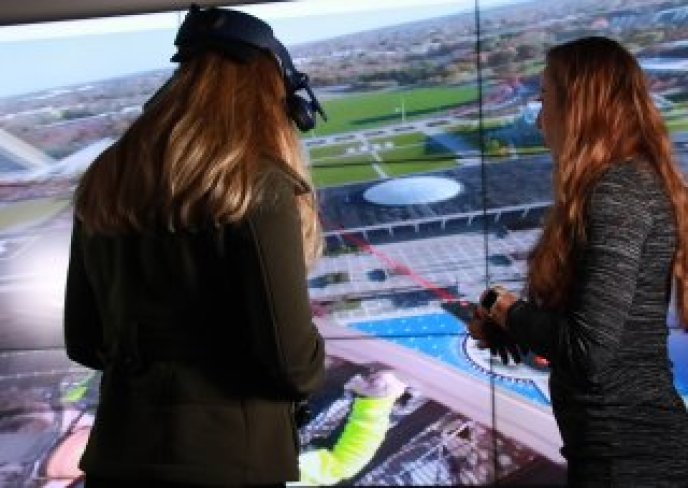
The ExTreme Collaboration, Innovation, and Technology (xCITE) laboratory is a state-of-the-art software development and scientific visualization facility house within the Atmospheric Sciences Research Center.

Located in the heart of New York’s Adirondack Mountains, Whiteface Observatory provides unparalleled facilities to conduct innovative and socially important atmospheric and environmental science research and education.
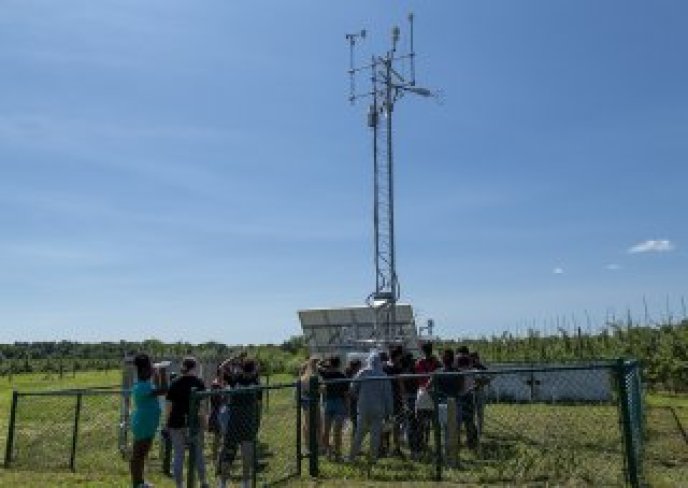
The NYS Mesonet is the centerpiece of New York’s Early Warning Weather Detection system, a network of 126 weather stations across the state, with at least one site in every county and borough.
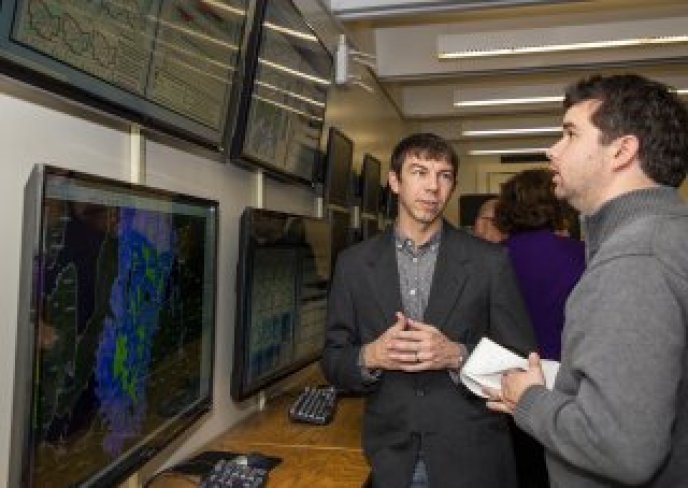
The New York State Center of Excellence in Weather & Climate Analytics is an entrepreneurial hub for more than 120 weather and climate faculty, researchers and staff based at UAlbany.

The State Weather Risk Communication Center (SWRCC) is a first-of-its-kind partnership between UAlbany researchers and state emergency managers that leverages the University's expertise in atmospheric sciences to help prepare for and respond to weather.
ASRC Mobile Measurement Platform
The mobile measurement platform consists of a diesel powered 2007 Dodge Sprinter 2500 Van equipped with a suite of fast time response advanced measurement instrumentation and systems to measure traditional criteria pollutants, temperature, GPS, radar and video tracking devices.



